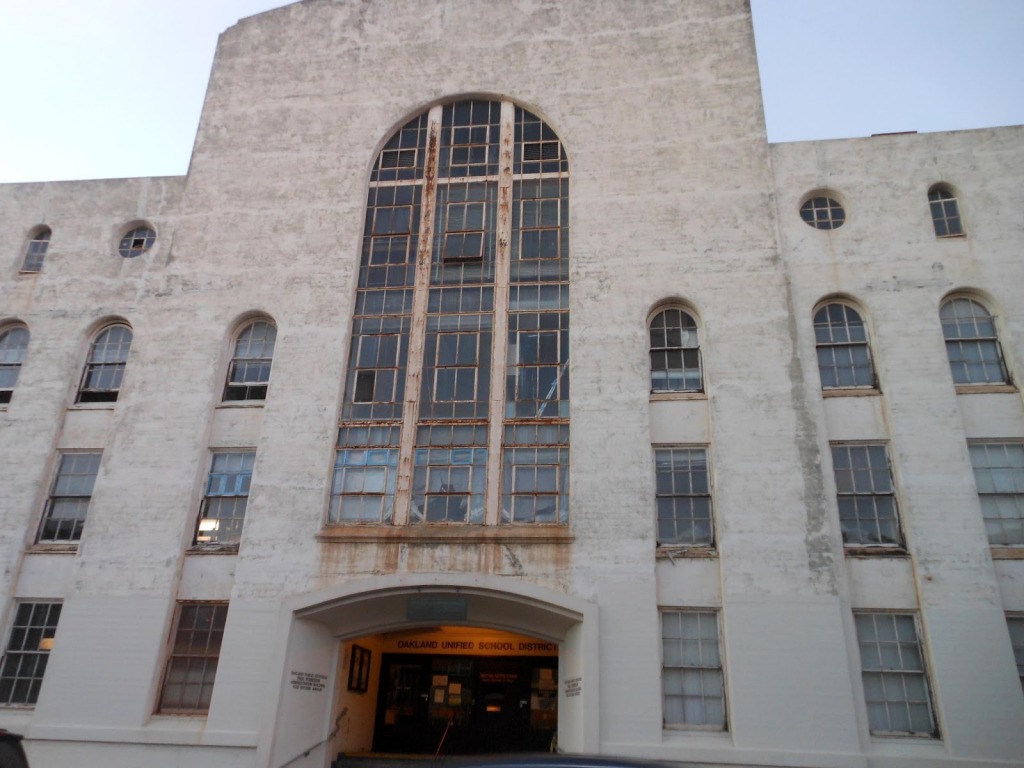Oakland Unified Says Its HQ Is “Presumed to Be Beyond Repair,” But Architects Say It Can Be Renovated for Half the Cost of New Building
Mar 14, 2015
Posted in Community, Economic Development, Education/Schools/Youth, Environment, Gentrification, Housing/Foreclosures, Labor, Oakland Job Programs, Responsive Government

By Ken Epstein
The Oakland Unified District seems to be acting on a presumption that its headquarters, the Paul Robeson Administration Building at 1025 Second Ave., was wrecked by a water leak and needs to be replaced at a cost of about $60 million, though the Board of Education has not yet made that determination.
The district, operating under this presumption, put out a request for qualifications (RFQ) for developers in July 2014 under the leadership of Gary Yee, former interim superintendent, and former Board President David Kakishiba.
But in a report prepared for the district in May 2013 by an architectural firm that inspected the headquarters “multiple times,” the “total construction cost” of repairing and renovating the building would be about $26,339,456, less than half the $60 million price tag that has been thrown around as the potential cost of a new building.
In the architectural firm’s report, the estimate of construction costs was based on a floor-by-floor look at the work “required due to water damage” and a “complete rehabilitation” of the headquarters, though “extensive building testing and investigations could lead to significantly more work than what (was) initially anticipated by this study.”
There is no indication that follow up investigations have ever been conducted.
According to the district, the damage was the result of a water leak (a faucet left on by a custodian) that occurred on the top floor of the administration building the night of Jan. 7, 2013, causing flooding on all four floors and significant damage to the entire structure.
Soon after the flooding, the district hired a firm, Hibser Yamauchi Architects, to do an evaluation of the structure. The firm completed its report on May 16, 2013.
The firm’s report found that basic repairs could be completed at an estimated cost of $7,342,666 and extensive renovation at the $26,339,456 price tag.
The schedule for design, permitting and construction of the basic repairs of the building project would be about 30 months, and major rehabilitation would take about 48 months, according to the firm’s report.
After evacuating the building, the district moved its central office staff to the Trans Pacific Center at 1000 Broadway and used space at several schools that had been previously closed.
The school district’s insurance company is currently reimbursing the cost of rent for the 11th and Broadway office space at $120,000 a month, or over $1.4 million a year.
In the July 2014 RFQ to potential developers of the administration building site, the district wrote: “The administration building and an adjacent building, also vacant, are both presumed to be beyond repair.”
That RFQ has received several proposals from developers but was put on hold until April after a number of vocal protests by students, teachers and community members who criticized the process, saying it had not been democratic or transparent.
Asked whether the Board of Education has decided to condemn the building, district spokesman Troy Flint told the Post in writing, “The decision of whether or not to demolish the building, renovate it, or some combination of the two, has not been made yet and will evolve from the ongoing community engagement process.
The $60 million price tag on a new building is only an informal estimate, Flint said.
“Ultimately, the cost of the project will depend on the design that’s sent to the Board of Education and what its members are willing to approve,” he wrote to the Post.
“The $60 million figure has been floated in informal discussions as a starting point for debate on what the district might be willing to spend, but that’s just spitballing at this point, no commitments or decisions have been made.”
The board’s three priorities for the project include building “a 21st century school for Dewey (Academy) students,” who will lose their present school if the site is sold to a developer; unifying “central leadership into a centrally located building for ease of access to the community (and) complete construction by January 2019,” Flint said.
Despite the district’s claims that the decision on what to do with the administration building will emerge out of a “community engagement process,” community members of the engagement committee have complained that they are not being given enough information to produce an informed recommendation.

An examination of what to do with the existing building has been “referred” to at meetings of the engagement committee, “but it has not been thoroughly explored,” said Naomi Schiff of the Oakland Heritage Alliance and a community member of the committee.
“It has come up, because I raised it,” said Schiff. “There are people who only want new –because they like new,” Schiff said. “But there may be other possibilities from the point of view of the Oakland Heritage Alliance. It’s a cultural resource, and its (potential renovation) needs to be studied.”
“The reuse of historic buildings is often the greenest alternative,” she said.